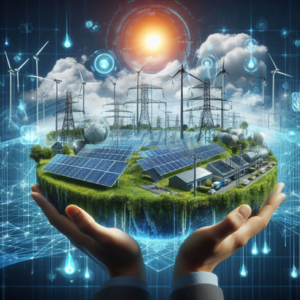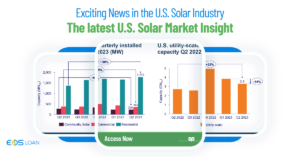The recent approval in the United States of the Inflation Reduction Act marks a significant turning point in addressing both inflationary and climate issues plaguing the country.
This legislation, enacted in August 2022, not only aims to combat inflation but also revolutionizes the energy landscape by providing a support platform for the expansion of solar energy and a large-scale energy transition.
Below, we will discuss the implications of this law and how it creates an opportunity for solar energy in the United States.
Understanding the Inflation Reduction Act
The Inflation Reduction Act is a multifaceted response to the inflationary pressures affecting the United States, exacerbated by the COVID-19 crisis and the Russia-Ukraine conflict.
In addition to tackling inflation, this legislation allocates $430 billion to address climate change and establishes core pillars such as promoting affordable medications, taxing large corporations, and, critically, investing in low-carbon technologies.
These purposes are crucial to ensuring a strong economic recovery and a successful energy transition in the present time.
During a recent fundraising event, President Biden voiced his reservations about the title of one of his significant legislative landmarks. Speaking in Park City, Utah, Biden remarked, “Although it’s named the Inflation Reduction Act, in retrospect, it might not have been the most accurate title. The essence of this act leans more toward establishing sustainable alternatives that can fuel economic progress rather than directly curbing inflation.”
Energy Challenges and the Transition to Clean Energy
The global energy sector faces a dynamic environment as climate change and the demand for clean energies drive the energy transition.
The disruption of supply chains due to the pandemic and volatile oil prices have exacerbated the situation, highlighting the urgent need for diversification and sustainability.
The Inflation Reduction Act represents an unprecedented commitment to clean energy, introducing more than 20 revamped or new tax incentives and substantial grant and loan programs, aimed at fostering investments in clean energy technologies and accelerating the transition to a clean energy economy.
It is formulated to bring about sweeping changes, emphasizing the creation of a low-carbon energy system through American technology and focusing on delivering reduced energy costs and good-paying jobs, especially in communities that are underserved or overburdened by pollution.
To combat climate change, a significant shift to cleaner energy sources in America’s energy system, beginning with the electric power sector, is essential.
President Biden has set bold goals including achieving 100 percent carbon pollution-free electricity by 2035 and attaining net zero emissions across the economy by 2050.
The Act allocates billions in grants and loans to hasten the deployment of clean energy projects to achieve these targets, giving precedence to projects in disadvantaged and energy communities.
Funding Overview
The Act extends and modifies the existing Production Tax Credit (PTC) and Investment Tax Credit (ITC) through 2023 and 2024, focusing on incentivizing investments in disadvantaged communities and ensuring the creation of well-paid jobs.
It allots $27 billion to the Environmental Protection Agency for the Greenhouse Gas Reduction Fund, aiming to grant competitive awards to catalyze financing for projects emphasizing the reduction of greenhouse gas emissions in low-income and disadvantaged communities.
The Department of Energy is granted $40 billion in loan authority, supported by $3.6 billion in credit subsidy, to back loans for pioneering clean energy projects including renewable energy systems and carbon capture.
Tax Provisions
Most tax credits provided in the Act are eligible for direct pay and are transferable. Entities like state, local, and Tribal governments, which typically do not benefit from income tax credits, can opt to receive some of the Act’s tax credits as direct payments. Moreover, certain tax credits can be transferred by ineligible taxpayers to unrelated parties in exchange for cash.
This landmark Act is poised to act as a catalyst for the deployment of both existing and innovative clean energy technologies, marking a strategic move towards a sustainable and equitable energy future while addressing the urgent needs of the climate crisis and community welfare.
Revitalizing American Manufacturing to Build the Clean Energy Economy
The Inflation Reduction Act also offers a significant opportunity to propel America’s economic and foreign policy ambitions.
As the country channels billions into the rapid adoption of clean energy technologies, the Administration is set on framing initiatives that reinforce domestic manufacturing, create lucrative jobs, and curtail dependence on foreign sources for essential clean energy components.
Funding Highlights
The Act sanctions up to $250 billion for the Energy Infrastructure Reinvestment Financing. With a $5 billion credit subsidy, the Department of Energy is empowered to guarantee loans for projects that transform or update energy infrastructure, potentially benefitting energy communities.
This could span projects like establishing clean energy plants on former coal mine locations or enhancing existing energy facilities with pollution mitigation methods.
The Advanced Energy Project Credit undergoes expansion, offering the Treasury Secretary the authority to allocate $10 billion for projects that focus on producing or recycling renewable energy equipment, cutting greenhouse gas emissions by a minimum of 20%, or handling critical materials.
Remarkably, 40% of these investments are reserved for energy communities affected by the closure of coal mines or coal-powered electric units.
A novel Advanced Manufacturing Production Credit has been introduced, targeting the domestic production of vital components in the clean energy supply chain, such as solar module parts and battery cells.
Both the Advanced Energy Project Credit (48C) and the Advanced Manufacturing Production Credit (45X) are structured to be directly payable and transferable.
Many of the Act’s tax benefits, inclusive of the 48C and 45X credits, are extended to entities like local governments that typically aren’t beneficiaries of income tax credits. Some businesses also have the option to receive the 45X tax credits as direct payments.
Certain tax credits can be transferred, allowing ineligible taxpayers to exchange some credits for cash with unrelated parties.
This legislation is an instrumental step in bolstering the nation’s clean energy ecosystem, while simultaneously invigorating its manufacturing sector.
Promotion of Clean Vehicle Adoption and Manufacturing
The U.S. transportation sector is responsible for over a quarter of the country’s total greenhouse gas emissions, with a significant contribution also to smog-causing pollutants.
Recognizing this, President Biden has aimed for half of all new passenger vehicles sold by 2030 to be zero-emissions, encompassing battery, hybrid, and fuel cell technologies. Additionally, in 2022, he launched the American Battery Materials Initiative, focusing on securing sustainable supplies of essential minerals for these vehicles.
The Inflation Reduction Act responds to these challenges by offering incentives for clean vehicle adoption, manufacturing, and sourcing within the U.S.
The Act further amplifies investments from the Bipartisan Infrastructure Law by setting aside funds for electric vehicle charging infrastructure, sourcing minerals for EV batteries, and supporting green public transportation.
Additionally, the CHIPS and Science Act boosts the production of semiconductors vital for electric vehicles.
Collectively, these legislative actions aim to invigorate the automotive sector’s supply chain, boost employment opportunities, and significantly reduce pollutants, benefiting especially the vulnerable communities most affected by poor air quality.
Financial Overview of the Inflation Reduction Act
The Act proposes substantial financial incentives to enhance the adoption of clean vehicles and ensure their parts are made in the U.S. Key initiatives include:
- A Clean Vehicle Credit of up to $7,500 for eligible new clean vehicle purchases.
- A first-ever credit of up to $4,000 to promote the purchase of used electric vehicles.
- A Commercial Clean Vehicles Credit, covering up to 30% of the replacement costs for commercial vehicles transitioning to electric options.
- Significant funding for manufacturers to expand domestic production of green vehicles and associated parts.
- A $1 billion allocation for the Clean Heavy-Duty Vehicle Program, prioritizing areas failing to meet national air standards.
The Inflation Reduction Act also presents certain tax credits, including the Alternative Fuel Vehicle Refueling Property Credit and the Commercial Clean Vehicles Credit. From 2024, buyers can transfer some of these credits to dealers, enabling immediate price reductions during vehicle purchases.
Expanding America’s Leadership in Industrial Decarbonization and Carbon Management
The U.S. industrial sector, responsible for nearly one-third of the nation’s greenhouse gas emissions, is crucial to the nation’s economy and security but challenging to decarbonize.
Key sectors like steel, aluminum, and concrete are integral to the clean energy and infrastructure supply chain.
The Inflation Reduction Act is aimed at advancing industrial decarbonization and carbon management, committing billions for the deployment of technologies like carbon capture and storage (CCS). The legislation includes:
- Investment in Clean Manufacturing: A vision for the U.S. to lead in producing electric vehicles, wind turbines, solar panels, and in rebuilding infrastructure using low-carbon materials.
- Funding and Tax Credits: The Act grants billions to decarbonize industrial facilities, enhance CCS, and manage direct air capture technologies. This supplements the $12 billion allocated in the Bipartisan Infrastructure Law over five years for carbon management and research.
- Climate Super-pollutant Mitigation: Additional funds are set aside for the Environmental Protection Agency to tackle major climate pollutants like hydrofluorocarbons and methane.
Key Allocations
- $5.8 billion for the Advanced Industrial Facilities Deployment Program, supporting emissions-intensive sectors.
- Expansion of the Advanced Energy Project Credit to cover industrial emissions reduction.
- Extension of the 45Q tax credit for carbon capture, with a focus on carbon capture and direct air capture projects.
- $1.55 billion dedicated to reducing methane pollution from the oil and gas industry.
- $38.5 million for the American Innovation and Manufacturing (AIM) Act, a plan to reduce the use of hydrofluorocarbons.
- Tax Incentives and Transfers: The 45Q credit, among others, is made available to entities typically not benefitting from income tax credits. These credits can be directly paid or transferred, allowing various entities, including state and Tribal governments, to capitalize.
The Inflation Reduction Act’s initiatives reflect a comprehensive effort to revolutionize the industrial sector’s approach to carbon management and emission reductions.
Engage in the Conversation
Did you find the content helpful? Share your opinion with us in the comments below and share this article with your friends who would like to learn more about the Inflation Reduction Act and how it presents an opportunity for solar energy.





